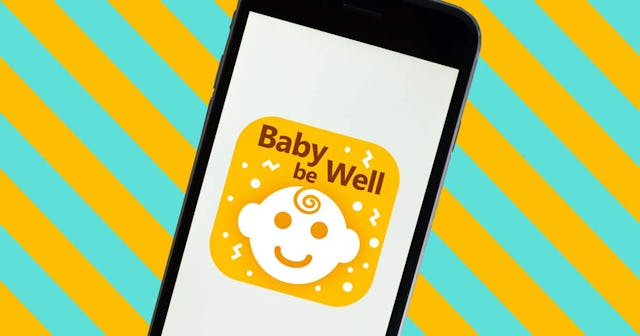A New (Free) App Can Help Reduce The Risk Factors Of SIDS

With the Safe Sleep for Babies Act of 2019 being passed just a few days ago, and a new SIDS prevention app having launched just last week, America is taking great strides to reduce the 1,500+ SIDS deaths still happening in our nation each year.
Physicians from Rutgers Robert Wood Johnson Medical School in New Jersey teamed up with Microsoft to create the Baby Be Well free and interactive mobile app which promotes safe sleep for babies under one year, while also acting as a virtual baby book that can be shared with select friends and family members.
“[T]he app is designed as a traditional baby book where parents can upload photographs and milestones and even track day-to-day activities such as feedings,” Thomas Hegyl, Professor of Pediatrics at Rutgers Robert Wood Johnson Medical School and involved with the app’s creation, says in a press release. “Parents can share their personal account with grandparents and other caregivers, therefore, along with the keepsakes and schedules, recipients also receive safe sleep tips and reminders.”
Contrary to it’s misleading name — “Sudden Infant Death Syndrome” — SIDS isn’t actually a syndrome at all. It is a cause of death given when no other causes of death can be proven. When accidental suffocation (or positional asphyxia) is highly suspected but there is not enough tangible, physical evidence to draw concrete conclusions, it is likely that a SIDS or SUIDS (Sudden Unexpected Infant Death Syndrome) cause of death will be given. And according to the CDC, unsafe sleep makes up a whopping 26% of these infant deaths.
“Although, by definition, SIDS remains a death in the first 12 months of life for which no explanation has been found, the conditions that reduce the risk of its occurrence have been identified,” Barbara M. Ostfield, PhD, Professor for the Department of Pediatrics at Rutgers Robert Wood Johnson Medical Center and Program Director for the SIDS Center of New Jersey, tells Scary Mommy.
These conditions Ostfield speaks of are safe sleep practices drawn from extensive research with the American Academy of Pediatrics (AAP). According to the AAP, babies should sleep on a flat surface, alone, and on their backs for the first year of their life. Parents should abstain from alcohol, drug, and tobacco use during this time for maximum safety and optimal parental supervision of their baby too.
Baby Be Well
When most mothers and fathers leave the hospital with their newborn, or have brought their adopted infant home, there is little education given to them about SIDS risk factors beyond the basics. The spotlight is often on how preventable SIDS deaths can happen due to unsafe sleep, but we should also be informing parents why these SIDS deaths can happen during unsafe sleep.
If an infant is placed to sleep in an unsafe environment, especially if they are younger than four months old, they do not have the head or neck control needed to re-position themselves if necessary. Even if there is no substantial obstruction to the infant’s airways (a pillow, blanket, mattress, caregiver’s body, etc. pressing against or covering the mouth and nose), placing an infant to sleep unsafely can create a “pocket” of limited oxygen for them to breathe, thereby causing them to continuously rebreathe previously exhaled air. This is also known as carbon dioxide rebreathing, which can be fatal.
Since the Safe is Best, otherwise known as Back is Best, initiative was launched — a campaign advocating for the AAP’s guidelines for safe sleep — America has seen more than a 60% decrease in the overall number of SIDS deaths in 20 years. All of this indicates that the preventative measures parents are instructed to take against SIDS really can and do work.
Out of all infant deaths, 80% of them can be attributed to SIDS/SUIDS deaths, but physicians at Rutgers Robert Wood Johnson Medical School and the SIDS Center of New Jersey are hoping to change that. Because as Heigyl says, “Knowledge only works when it is shared and used.”
“We focused on making the app an appealing and interactive experience to promote return visits and repeated exposure to the safe infant sleep guidelines of the American Academy of Pediatrics,” Ostfield adds. “We found that those reminders help maintain awareness and adherence not only when a child is born, but throughout the first year.”
Not only does this engaging app help remind the parent’s of safe sleep habits, but the Baby Be Well experience was designed to be shared amongst grandparents and/or other care providers too. Before the Back is Best campaign was launched in 1994, over 70% of infants were sleeping on their bellies. Times have changed, and this app’s daily “tip of the day” can be life changing for infants with caregivers who were taught different ways to put an infant to sleep.
“Encouraging grandparents to become frequent visitors to this app also is important because advice on safe sleep has changed so much since we raised our own children,” Ostfeld says.
The Baby Be Well app is available in the Android app-store and will be available on iOS devices shortly.
Safe sleep matters, and there is decades worth of research that proves it.
This article was originally published on